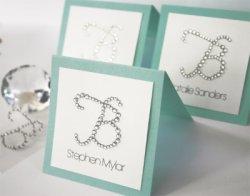Written by Tracy Bloom Schwartz, Creative Parties Bethesda, MD
Escort Cards: These cards are used to let each guest know what table they are assigned to. The classic escort card is a small envelope with the guest name on the envelope and the table assignment on the card inside. You can use the words "You are seated at table ___ " or you can just give the table number assignment, as the word table is implied. For a very personal touch, you could write a note to each guest. A tent card, folded at the top, is also as an escort card.
The design of these cards is only limited by your imagination. They can have bows, dried flowers, ribbons or anything that compliments the theme. You can use any color of ink. They can even be a "thing". We are doing a summer wedding and using a heart shaped seed packet with an organza ribbon as the escort card. At another wedding we are putting the card in a charming, small silver and gold flowerpot, which then becomes a gift for the guest. We have used colored stones. The important thing to think about is that the guest has to hold on to this "card" until they go into the formal part of the evening.
What you write on the escort card: The most formal designation is: Mr. and Mrs. Robert Smith. This is the same as how the guests were addressed on the formal invitation envelope.
Informal alternative: Mary and Robert Smith
~ If someone brings a guest, you can either put their name on the same card or you can have two separate cards. If you choose to use one card for both, the woman should be listed first, though many people put their invited guest first even if it is a man.
~ If a husband and wife have different names, we usually put the women's name first.
~ When putting these cards on a table, we always put them in alphabetical order.
Place Card: The place card is on the table at the place assigned to the guest. There is a choice in where you seat your guest at the table.
Some of the choices are:
1. Husbands and wives (or couples that come together) are seated at the same table, but not next to one another. In this case guests should alternate, male and female. The person seated to the right of another is considered in the position of honor.
2. Couples that come together are seated next to one another.
3. Couples that come together are seated at different tables.
4. At a round table, the best seat is facing the honored guest.
The place card itself can vary from the most formal, an ecru or white card with a, gold or silver bevel edge laid on a formal folded napkin to a theme related card or item, such as a Mardi Gras mask. The only requirement is that the name be on it somewhere.
What you write on the place card: In the formal approach, the name is written: Mr. Jones, if there are two Mr. Jones at the table than the first name is used, i.e. Mr. Mark Jones. In an informal approach you can use either Mark Jones or Mark. The last name would be required if there are more than one of that name at the table. The important issue is to be consistent.
Personalized menu cards: A personalized menu card is an alternative to a place card. These should be considered when giving your guests a choice of entree. The regular menu would have each guest's name printed at the top and set at each place. If the menu card is not personalized, you may chose to only use 3 or 4 menus at the table or one at each place. A new trend is CHOCOLATE menu cards! What a way to leave a sweet taste in the mouth of your guests.
Name Cards: These are usually ginve by graduates, but can be used in the invitations so that guests know they should sit on the bride or groom's side. This helps in evening out the chapel if the bide or the groom has less guests. It does not refer to anything that relates to a table setting.
Place Cards & Escort Cards - What's the Difference
This question comes up frequently and people use the word interchangeably. In fact, there is a difference.
Category:


